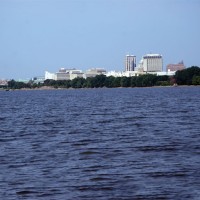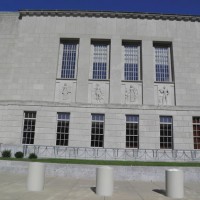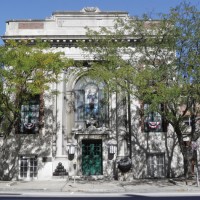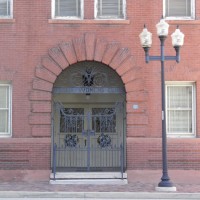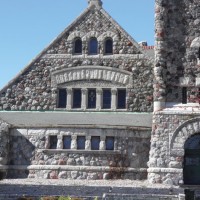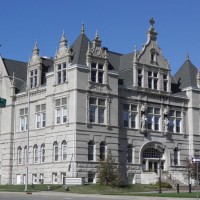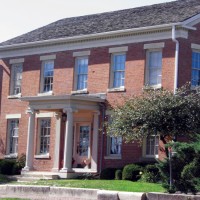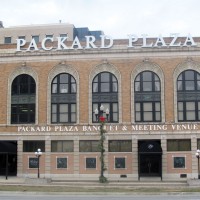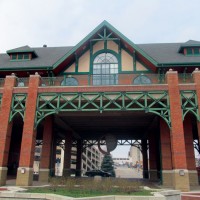Voices
Peoria's Surprising Architecture: Part Two
- Details
- Published on Sunday, 01 January 2012 16:15
- Written by Dr. Peter J. Couri
Upcoming issues of The Peorian will feature walking tours of Peoria's more interesting areas. This issue is the second of three parts about Downtown Peoria.
French explorers settled among the native peoples here in 1691 to start Illinois' oldest European settlement. The French villages here lasted for 120 years until the French and native peoples were forcibly removed by American soldiers during the War of 1812. The American soldiers then built Fort Clark in 1813. You can walk one block south of Main Street to Liberty Street where a pavilion containing a historic marker commemorates the founding of Fort Clark with French, British, Spanish and American flags flying.
In the last issue, we featured nine buildings that have made up Peoria's past. Our walking tour
of Downtown Peoria continues this month at the corner of Main and Monroe with...
10. Peoria Post Office & Federal Courthouse
110 N.E. Monroe Street
The corner of Main and Monroe once was the site of an 1880s massive Victorian post office. During the Great Depression in the 1930s, people were put back to work with the construction of new post offices across the nation. Finished in 1937, Peoria's new post office and federal courthouse displayed the clean lines of the international architectural style. The interior is exquisitely decorated with large panels of rose marble and gold-leaf art deco decorations.
A Chicago sculptor named Freeman Schoolcraft was hired by the WPA to carve four limestone sculptures to enhance the new post office. He created in a pure art deco style, from left to right, the man of industry, the woman of agriculture, the Native American, and the postal worker. He asked a man from the Pottawatomie tribe whose ancestors lived in the Peoria area to pose for the Native American panel. And he did take artistic license with the half nude woman postal worker.
Proceed down Monroe to Hamilton Boulevard where you will find the...
11. Grand Army of the Republic Hall
416 Hamilton Boulevard
This building became the permanent home for Civil War veterans in 1909 through the generous donation of millionaire distiller Joseph Greenhut. As the Civil War was fading from memory, they planned a building that would always remind Americans of the sacrifices endured during that traumatic time. The hall is of the neo-classical Beaux-Arts architectural style.
They hired Peoria sculptor Joseph Petarde to decorate the façade with all the classic Grand Army of the Republic symbols such as the American eagles, funeral urns and floral garlands. The original arched stained glass window was damaged in a storm, but was recently restored to its original design. A mortar and pyramid of shot flank the entrance.
The hall is filled with many original historic paintings and prints. At the top of the grand staircase is a marble bust of General John Logan from Illinois who was the founder of Memorial Day. It was carved by Peoria sculptor Fritz Triebel.
Walk down Madison to Fayette Street where you will encounter the...
12. The Peoria Woman's Club
301 N. E. Madison
This Romanesque-style building still remains preserved today as it was built in 1893. Maintained by the original club, it houses beautiful paintings, murals and furniture from its Victorian era beginnings.
The second floor houses a raised stage theater with the original seats, decorative iron work and curtains.
Cross over the expressway bridge to...
13. Second Presbyterian Church
(Cornerstone Building)
321 N. E. Madison
This church was dedicated in 1889. It was designed by Chicago architect W. W. Boyington who is famous for his Chicago Water Tower. Its style is called Richardsonian Romanesque with its rough heavy stone walls, gables, towers and arches. The members of the parish contributed fieldstones from across Illinois to finish the church.
Now used as a banquet hall and offices, the interior still has the massive pine beams, exquisite stained glass windows and ornate metal light fixtures that were in the original church.
Cross Spalding Avenue to...
14. Spalding Institute
(Cursillo Renewal Center)
401 N. E. Madison
Spalding Institute was a Roman Catholic high school for boys for almost a century. It was entirely paid for by the first Catholic Bishop of Peoria, John Lancaster Spalding, in 1898. He was also the founder of the Catholic University of America in Washington DC.
Spalding pushed Reeves & Baillie, the architects, to design "a substantial building that would have a strong and permanent presence in Peoria." Their homage to the French chateaus and German manor houses of Europe is evident.
Walk one block down Spalding Avenue to Jefferson Street to find the...
15. Judge Jacob Gale House
403 N. E. Madison
This is the oldest standing house in Downtown Peoria. It was built in 1842 in the Greek Revival style by Judge Jacob Gale, a prominent pioneer attorney in early Peoria. Gale was elected to be the 4th mayor of the city in 1848, and then again during the Civil War in 1864.
Walk down Jefferson and turn left onto Hamilton Boulevard. On Adams Street to your left is...
16. Packard Automobile Agency
(Packard Plaza)
211 N. E. Madison
The Packard Plaza was designed by Frederick Klein in 1927 in an Italian Renaissance style as can be seen in the three-story arched terra cotta windows. The building is quite unique because the first floor housed a Packard Automobile dealership, the second floor was a bowling alley and the third floor was the concession area with balconies that overlooked the bowling alley.
Atop the building was an open-air rooftop bar and garden where music would play far into the night.
Proceed down Hamilton Boulevard. to the riverfront to...
17. Gateway Building
211 N. E. Madison
This building was constructed in 1997 to serve as the focal point to a reenergized Peoria riverfront park. Hanging in the welcome arch is "Recognition Moon" by Peoria sculptor Bob Emser. It is one of many sculpture art pieces that make a peaceful river walk up and down the park.
Look for Part III of our tour in the next issue of The Peorian.















































